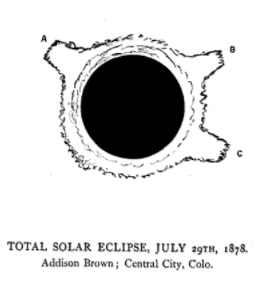
Addison Brown. Wikipedia image.
When you think of federal district judges, you generally don’t think of botany or astronomy. But that’s because you haven’t heard of Judge Addison Brown, Judge of the U.S. District Court for the Southern District of New York.
In 1878, while a New York attorney, Brown traveled to Colorado to observe a total eclipse. His observations of the eclipse were published by the Naval Observatory in 1880.
Brown first notes that his telescope “arrived uninjured after its journey of 2000 miles,” and then laments that during the week previous to the eclipse, his bodily indisposition prevented his performing a fair share of the preliminary work of his team’s mountain encampment at an elevation of 9000 feet. Nonetheless, Brown kept the chronometer properly set, relying upon a colleague at Central City, CO, which had telegraphic communication with Washington in order to receive daily time signals from the Naval Observatory.

One of Brown’s sketches of the 1878 eclipse. Google Books.
Brown apparently overcame his altitude sickness and was in camp the day of the eclipse on July 29, 1878. He noted that “the only disadvantage of the elevated station was its exposure to the high southerly and westerly winds which prevailed. On the morning of the eclipse, warned by the furious gale of the day previous, which nearly carried away our encampment, the telescope was removed to the partial shelter at the rear of our extemporized observatory, where comparative quiet was secured. In other respects, the day was faultless; the atmosphere was clear and brilliant, and the few fleecy clouds that appeared after noon offered no obstruction to our work.”
To ensure that his eyes would adjust to having good night vision at the moment of totality, Brown bound a bandage around his eyes five minutes before totality. Upon totality, he removed the bandage, allowing him to make his description of the corona. Brown notes that, to his surprise, “the light was sufficient to read the print of the New York Tribune’s editorials without difficulty.” He described the corona as having a yellowish hue, rather than the “pearly white” he had expected.
After ten seconds’ observation of the corona, Brown turned his attention to the horizon, which was a “gorgeous glow of orange-yellow light, with scarcely any red intermingled.” The wind, which had been strong before the eclipse, gradually lessened as totality approached. By the time of totality, it was hushed to nearly a perfect calm.
After observing the horizon for but a few precious seconds, Brown returned to his telescope, where he made more observations of the corona, the sketches of which were included in his accounts.
Judge Brown’s scientific pursuits were not limited to astronomy. Brown was the author, along with Nathaniel Lord Britton, of the three-volume Illustrated Flora of the Northern United States and Canada, which is still available from Amazon at the links below.
Brown was named to the bench as a recess appointment by President Garfield in 1881. He was formally nominated and confirmed by the Senate later that year. He retired in 1901 and died in 1913.
